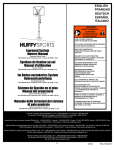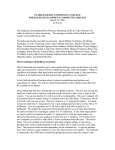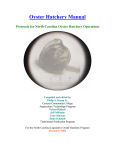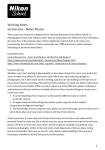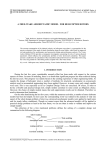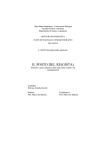Download PFLI Leonard Victor Competition
Transcript
Volume 33 Number 10 June 2004 PFLI Leonard Victor Competition The annual Leonard Victor Competition will be held at the Old Bethpage Restoration on June 11th at 8 pm. You may enter up to 5 images in each category that you scored at least 21 points during the 2003-2004 Season. There are no entry forms to fill out, just bring your prints or slides the night of the competition. Three non-PFLI judges will select the top 3 images in each of the 6 competition categories and a special plaque will be awarded to the 18 winners at Honors Night in the fall. Camera Basics Whether you are using a digital, film, or point and shoot camera of either variety, the basics of exposure are the same. The variables are shutter speed, lens aperture (f-stop), and film speed or sensor sensitivity. Exposure is the cumulative effect of light on a photosensitive surface. It is controlled by a combination of shutter speed and lens opening. Let’s start by understanding how each variable operates. The shutter- the shutter is like a curtain that keeps light out of the camera except during exposure. When a picture is taken, the shutter opens for a specified period of time measured in fractions of a second to seconds for ‘time’ exposures. As a generalization, interchangeable lens SLR cameras have focal plane shutters. This means that the shutter is like a curtain that opens and closes in front of the film. Other cameras generally use a “leaf” type shutter between the elements of the lens. The diaphragm- an ‘iris diaphragm’ controls the size of the lens opening just like the iris of the human eye conrolls pupil size. That is, it reduces the diameter of the lens. When the lens is “wide open,” the diaphragm has no effect. As it closes, the quantity of light that can pass through the lens per unit of time is reduced. Lens openings (apertures) are measure by ‘f-stops’. An f-stop is a number that indicates the ratio of focal length of the lens to its diameter. The following is the order of f-stops marked on a typical 50 mm lens that has a maximum opening of f 1.4. 1.4 2.0 2.8 4 5.6 8 11 16 22 Note: The complexity and design considerations of modern zoom lenses make lenses with openings greater than f 4 somewhat exotic and very expensive. f 1.4 and f1.2 lenses were common in the past and made available light photography more commonplace in the past than now. Until you understand the basis of this system, the numbers may appear arbitrary. For now, take my word for it- they make sense. As you go up the scale, each number represents a lens opening that lets in ½ the amount light of the previous number. For example, when you go from f 1.4 to f 2.0, the amount of light admitted is halved. When you go from f 1.4 to f 4, you have gone through 3 stops, Therefore, the exposure is reduced by a factor of 8 (2,4,8). It makes sense that the amount of light that passes through the aperture is directly proportional to the area of the opening. f-stops are related to the area the lens opening which in turn is related to diameter by a formula you learned in high school math. page 1 ⎡d ⎤ A = π⎢ ⎥ ⎣2⎦ Officers 2 President Sy Roth Using our 50 mm lens example, at f 2 the diameter of the lens is 50/2 = 25 mm. The area of a 25 mm circle is 500 mm2. At f 2.8 the diameter is 50 mm/2.8 = 17.9 mm and the area is 250 mm2. Eureka! That explains the seemingly arcane numerical relationship. When we changed the lens opening by a one f-stop higher number, the area of the lens opening was halved. You can think of it as a bucket of water with a hole in the bottom. Regardless of the size of the hole, each time you double the area of the hole, the quantity of water flowing through it will double. The important thing to understand is the doubling relationship. As you double shutter speed, you must increase the lens opening by 1 f-stop to maintain the same exposure. In other words, 1/10 sec. @ f 22 = 1/20 sec @ f 16 = 1/40 sec @ f 11 = 1/80 sec @ f 8 = 1/160 sec @ f5.6 etc.. in practice, with mechanical shutters, we round off the shutter speeds to the commonly marked values such as 1/125 sec, 1/250 sec and so on. Cameras with electonically controlled shutters will frequently have intermediate shutter speeds. 516-433-2516 Vice President Aileen Harrison 516-938-6769 Second VP Bill Schmidt 631-266-3354 Treasurer Carol Greenberg 516-674-6056 Secretary Judy Ruderman 516-935-8742 Programs Mel Wachspress Judges Moshe Markewitz Membership & Records Orrin Edwards Aside from controlling the amount of light entering the camera, lens openings have an effect on the distance between the nearest and farthest objects from the camera that are “in focus.” This phenomenon is called “depth of field,” which is dependent upon three factors: 1. Focal length- the longer the focal length, the shallower the depth of field. 2. f-stop- The wider the lens opening (smaller f-stop) the shallower the depth of field. 3. Lens to subject distance- the closer the subject the shallower the depth of field. Because the plane of critical focus can be controlled, depth of field is an important creative tool. It allows us to make backgrounds appear “soft” and non-distracting when photographing things at close range such as in portraits and macro photography. Conversely, when we want everything to be in sharp focus, we must use a small (larger fstop number) lens opening. SLRs have a mechanism that keeps the diaphragm wide open during focusing and light measurement, and closes it to the pre-set opening during the exposure. This is to aide in focusing and composure. The ‘stop-down preview’ control on high-end models, allows you to view the scene at the set fstop, so that you can estimate the depth of field visually. Hopefully, this article has clarified some of the mystery behind camera nomenclature. Even if you have a point and shoot camera that does not allow manual settings, an understanding of what the camera can do will help you make photographs of greater impact. page 2 Exhibits Gerald Harrison Aileen Harrison Field Trips Alan Agdern Peter Metzger PFLI Delegate Sy Roth Publicity Gerald Harrison Aileen Harrison Olympus Liaison Mel Wachspress Moshe Markewitz Viewfinder Editor Barry Goldstein barryg@gbroline com Camcorder by Carol Goldstein This take is making me seasick. Was that a picture of your shoe? “You’ll have to pan much slower!” Hold the camera steady too! That zoom-in of your mother is more than I wanted to see. Next time we go out on a shoot, Leave the camcorder to me! Annual Dinner The Annual Dinner at the Milleridge Inn will start with D'Oeurves at 6:30 pm. The menu will be: Hors d'oeuvre Soup Du Jour Mixed Green Salad Choice of entree Roast Prime Rib of Beef Grilled Fillet of Salmon with Pommery Mustard Sauce Roast L.I. Duckling A' Lorange Potato and vegetable Du Jour Milleridge Cheesecake Coffee, Tea, & Decaf April Theme Competition Results “Textures” Judged by Erich Lohse Black & White Prints “A” Print Of The Month- Barry Goldstein Eight- Moshe Markewitz Color Prints Class “B” Black & White Prints “B” Print Of The Month- Alan Ross Eight- Barry Goldstein, Ira Scheinerman, Judy Ruderman Print Of The Month- Maylan Monahan Nine- Bill Schmidt Color Slides Class “A” Slide Of The Month- None Color Prints Class “A” Print Of The Month- Carole Greenberg Nine- Alan Agdern Eight- Sy Roth Color Slides Class “B” Slide of the Month- None May Competition Results Judged by Art Donnelly Black & White Prints “A” Color Prints Class “B” Print Of The Month- Maylan Monahan Nine- Sarah Kleinman, Alan Ross Eight- Bill Schmidt, Jerome Sax Print Of The Month- Ira Scheinerman Nine- Bill Schmidt, Aileen Harrison Eight- Barry Goldstein, Carol Goldstein, Peter Metzger, Jerome Sax, Ira Sunshine, Linda Volin Black & White Prints “B” Color Slides Class “A” Print Of The Month- Maylan Monahan Nine- Bill Schmidt Slide Of The Month- Stan Rothman Nine- Ramesh Patwa Eight- Annette Fox Color Prints Class “A” Print Of The Month- Clem Kleinmann Nine- Gerald Harrison Eight- Alan Agdern, Sy Roth Color Slides Class “B” Slide of the Month- Maylan Monahan Eight- Linda Volin page 3 High Average Award Winners, 2003-04 Season Category Color Slides A Color Slides B Black & White A Black & White B Color Prints A Color Prints B First Place Ramesh Patwa Maylan Monahan Alan Agdern Bill Schmidt Alan Agdern Bill Schmidt Second Place Stan Rothman None Barry Goldstein Bill Bowie Gerald Harrison Jerome Sax Third Place Orrin Edwards None Orrin Edwards Jerome Sax Sy Roth Aileen Harrison Second Place Ramesh Patwa Barry Goldstein Alan Agdern Bill Schmidt Gerald Harrison Aileen Harrison Third Place Stan Rothman Linda Volin Barry Goldstein Maylan Monahan Alan Agdern Bill Schmidt Year-End Competition Results Category Color Slides A Color Slides B Black & White A Black & White B Color Prints A Color Prints B First Place Eugene Fox Maylan Monahan Orrin Edwards Bill Schmidt Alan Agdern Bill Schmidt BIRDING WITH THE HARRISONS Aileen Harrison New for the 2004-2005 Season At meeting of the Programs Committee chaired by Jerry Sax, it was decided to improve the educational component of our meetings by adding two pre-competition critique meetings. These critiques will take place two weeks before a regular competition, during which members will have the opportunity of presenting un-mounted prints for constructive criticism by a panel of experts. This will provide an opportunity to improve the photo prior to the competition. The first such meeting will take place in September, instead of the traditional “What I Did Last Summer” competition. (See the Meeting Schedule on the last page). There will also be presentations by members on several topics which may include Photoshop, composition, close ups, lighting, filters and Zoo Photography. If you have a suggestion for other topics, be sure to respond to the email when you get it, or contact Jerry Sax. We got up early The sun was bright We packed our gear Expecting quite a sight We went to where The birds should bunch We had tripods Bird feeder, seeds and lunch Only one bird And we came so far But it didn’t matter We left the cameras in the car. It was also decided to hold at least two theme competitions. Unless input from the membership changes the selection of topics, they will be “Children” and “Trees.” Digital Printing One of the advantages of digital cameras is the elimination of film and the cost of its development. Inkjet printing on photo quality paper can be expensive however. Let’s assume that you can make 25 high quality 8x10s from a set of inkjet cartridges. At a low price of $42.00 for a set, that’s $1.68 for ink. Add $0.80 for a sheet of Vendor Adorama Prolab BJ’s (kiosk) Bonus Print Costco Dot Photo EZ Prints Hi Tech (prices include 20% SCC disc.) Ofoto Shutterfly Snapfish Target Walgreen (Kiosk) page 4 4x6 5x7 0.29 0.69 0.18 0.19 0.29 0.29 0.24 0.29 0.39 0.25 0.29 0.29 0.69 0.95 0.85 0.80 0.99 0.99 0.95 8x10 11x14 12x18 2.99 4.99 1.99 1.99 2.95 2.45 1.60 3.99 3.99 3.79 4.99 6.99 4.99 9.99 2.99 5.99 3.95 4.80 7.99 9.99 10.10 5.60 17.99 8.5 x 11 paper and we’re up to $2.48 per print, assuming you get it right the first time. The following current prices are based on an order of a single print on glossy photo paper. All of the vendors are available on-line. Postage where applicable, is not included. This chart is not intended to be all-inclusive, but is representative of the prices out there at the time of my survey. So should you send it out or do it yourself? Part of the answer revolves around how much gratification you get by controlling the process from start to finish. I would submit however, that digital printing is not analogous to darkroom printing. There is very little control of the process at the printer level. You either have the process optimized or you don’t. Image manipulation is done either in the camera through custom settings and exposure, or in the computer using software. Direct Printing- If you prefer to do your own printing at home and don’t have or wish to use a computer, there are a number of ways to do it. Some printers have a slot where you can insert the cameras memory card. Kodak offers a printer with a “dock” that accepts the camera, eliminating the need to remove the memory card or to connect a cable. Other systems allow connection of the camera to a printer via a USB connection. If you want the convenience of making 4x6 prints at home and sending the rest out, you can get a dedicated 4x6 photo printer that connects directly to your camera. Retail outlets like CVS, Walgreen’s and others, offer digital print kiosks that accept your cameras card. The first thing to do is check your user’s manual to see if there is a setting for direct printing. If there is, use it. It will optimize your images to correspond with the printer’s color gamut and other characteristics. SCC PFLI Top Competition Scores for April Category Color Slides Class A Color Prints Class A Color Prints Class B Black & White Class B Member Stan Rothman Annette Fox Ramesh Patwah Alan Agdern Sy Roth Gerald Harrison Jerry Sax Ed Starling Bill Schmidt Alan Ross Linda Volin Bill Schmidt Points 22 22 21 24 23 21 23 22 22 21 21 22 Title Looking Up Early Morning Skier Tahiti Flower #10 Sunrise at the Triboro Bridge Trio of Roses Iquaza Falls Mrs. Binoculars Tuscon Doorway Mrs. Peacock Old Fashioned Girl Table and Chairs Name the Camera Last month’s mystery camera- Orrin Edwards and Phil Schaming of Sparta, NJ got it right. Last month’s Mystery Camera is a Kodak Pony 135. As noted, there was also an 828 roll film version of the camera. The Pony was not a great camera by any standard but provided the feel and spontaneity of 35 mm photography at a time (1950-1954) when German and Japanese 35 mm cameras were beyond the resources of many young amateurs. This month’s mystery camera- Manufactured in 1976, this camera was the first 35mm SLR camera to be controlled solely via a built-in Central Processing Unit. The camera which is shown in the two photos to the right, operates in shutter priority and manual modes. It is small, lightweight, ‘solid’ and easy to use. A 6-volt battery powers the camera. Over 5 million of this famous makers model were sold worldwide. If you page 5 think you know the answere, contact [email protected]. W.S.C.C. Aileen Harrison The D.S.C.C. (Dreaded Syosset Camera Club) has broken the chain. As of last Sunday we became the W.S.C.C. (Welcome Syosset Camera Club). We actually went to three different locations and weren’t kicked off or chased by any. We met at 5:00 am at the diner. The motley crew consisted of Gerry and Aileen Harrison, Linda and Stanley Volin, Carol Greenberg, Ira Sunshine, Ed Starling, Moshe Markewitz, Alan Agdern, Peter Metzger, and Ira Schneider man. First Stop was Hoboken, New Jersey to watch the sunrise behind the Manhattan skyline. Next was Liberty Park to see the back of the Statue of Liberty and Ellis Island. We figured if our luck was so good and nobody threw us out yet, we would go for broke. So, off we went to the Brooklyn Bridge. There was no parking to be had on the Manhattan side so we crossed over to Brooklyn. I think we got the best parking spot, which was just one block from the steps to the bridge. We then proceeded to actually walk across the bridge and back with CAMERAS. We all thought this was a “Real Cool Field Trip” and all had a good time. Digital Camera List If you have a question about your camera, the best person to ask first may be on this list. If you are not on the list yet, or if you have upgraded, please send the information to the Viewfinder ([email protected]). Camera Member’s Name Contact Canon A60 Bill Schmidt [email protected] Canon D60 Gerry Harrison [email protected] Canon D60 Sy Roth [email protected] Canon Digital Rebel Aileen Harrison [email protected] Canon G2 Ed Starling [email protected] Canon G2 Ramesh Patwa [email protected] Minolta Dimage 7i Irv Melnick [email protected] Nikon 8700 Frank Iraggi fotoguy@optonline .net Nikon Coolpix 4500 Alan Ross [email protected] Nikon Coolpix 990 Carol Goldstein [email protected] Nikon Coolpix 995 Carol Greenberg toad.brook@juno,com Nikon D100 Frank Iraggi fotoguy@optonline .net Nikon D70 Barry Goldstein [email protected] Nikon D70 Peter Metzger [email protected] Nikon D70 Richard Nussbaum [email protected] Olympus 750 Gerry Harrison [email protected] Olympus C50 Zoom Stan Rothman [email protected] Olympus C750 Ultra Zoom Moshe Markewitz [email protected] to the “Magic Lantern” is developed 1856- Tintype invented by Hamilton Smith 1887- Adolph Miethe and Johannes Gaedicke invent flash powder 1888- Kodak markets the first box camera 1889- Eastman uses flexible cellulose nitrate film base page 6 Highlights of Photo History 330 BC- Aristotle describes the Camera Obscura 1600- The pinhole camera is invented by Alhazen 1609- Kepler suggests the use of a lens to improve the image projected by the Camera Obscura 1827- Joseph Nicéphore Niépce makes the first fixed photographic image (8 hr. exposure) 1839- Sir John Herschel invents the word "Photography” 1840- William Henry Fox Talbot invents the process to use a negative to make multiple prints 1844- Louis Daguerre reduced exposure time to less than 30 minutes. (Developed the Daguerreotype in 1839) 1850- The Hyalotype, precursor 1906- Wratten & Mees invent the panchromatic plate 1930- Johannes Ostermeier invents the flashbulb, the “Vacublitz,” GE markets it as the “Sashalite” 1935- Kodachrome introduced (remains the most stable color film) 1965- NASA uses the first digital camera 1972- Texas Instruments patented a film-less camera 1981- Sony releases Mavica camera 1986- Fuji introduces the disposable camera 1986- Kodak scientists invent the first megapixel sensor (1.4 MP) 1990- Kodak markets Photo CD and color standard for digital environment 1991- Kodak releases a Nikon F-3 body with a 1.3 megapixel sensor 2004- Three SCC photographers take the same picture What is a Mired? Mired is an adjective that means ‘entangled’ or ‘hindered’, but a mired or “micro reciprocal degrees” in photographic terms is the reciprocal of degrees Kelvin multiplied by 1- million (a more modern notation is MK-1), So who cares? Mireds, or more commonly decamireds (mired x 10) are used as a measurement standard for converting light from one color temperature to another using color conversion filters. The older system, which is still in use was an innovation of Frederick Wratten. It is an arbitrarily numbered series of filters. Kodak bought the Wratten Company in 1912, and continued manufacturing filters under the Wratten name. The Wratten filter numbers are: 2 through 15 Pale to deep yellow 16 through 32 Orange, red, magenta 34 through 61 Violet, blue, green 80A through 80D Cooling (blue) 85N3 through 85C Warming (amber) 81 through 81D Warming (lt. yellow) bal. 82 through 82C Cooling (lt. blue) bal. 87 through 106 Misc. Decamired filters available in red and a blue series are designed to easily handle color temperature variations. The advantaged of decamired filters is that they can be numerically combined to create the required correction. A filter that produces a color temperature change of 1,000 K at 3,4000 K will produce a change of 10,000 K at 100,000 K. This is because the filters are designed to relate to a visual scale of color. The response of the human eye to color is more closely related to mireds than to degrees Kelvin. A color change of 1,000 K at the higher temperature would hardly be noticed. To see this more clearly, note the following changes in color temperature. From To K0 Mired K0 Mired 9,100 110 5,900 170 4,350 230 3,450 290 4,000 250 3,200 310 Difference K0 Mired 3,200 60 9,00 60 8,00 60 Note that although the magnitude of difference in degrees Kelvin varies as the range changes, the filtration difference in mireds is the same. In use, the mired value of the light source is subtracted from that of the film. If the result is positive, you use a warming filter (reddish); if negative, a cooling filter (bluish). These numbers are additive; meaning that a pair of R3's produces an R6. An R6 plus a B6 cancel each other out to produce a neutral gray. Now isn’t that better than the Wratten System? Bulletin Board PhotoPlus Expo and Conference 2004, October 21-23, 2004, Jacob Javits Convention Center- Register via website before september 30, for free registration. page 7 “Print and Photograph Portfolios” 6/1-7/29/04, Emily Lowe Gallery, Lowe Hall, Hofstra University International Center of Photography, “Only Skin Deep; Changing Visions of the American Self.” 1133 Ave of the Americas at 43rd St. (212) 768-4682. Adm. $8, Students/Senior $6. JoeDigitalPhoto, Introduction to Digital Photography lectures, Weds, 6/23, 7:00pm-8:30pm, West Islip Public Library. Thurs, 12/2/04, Brightwaters Public Library. These seminars are geared toward the beginner digital photography user. For additional information, contact the above public libraries. The website is www.joedigitalphoto.com. Greg Lyon a.k.a. JoeDigitalPhoto is a new member of the Syosset Camera Club. Nikon School of Photography, New York City, 5/15 or 5/16, 2004 Digital 101, 6/12, 2004, Digital 201, 6/13, 2004, See www.nikonschool.com for details Between Past and Future: New Photography and Video from China, New York Asia Society and Museum, 725 Park Ave, 6/11-9/5, Tue - Sun, 11:00 am - 6:00 pm, Fri. until 9:00 pm. Closed Mon. and holidays. Adm. Included with museum adm. $7 adults; $5 students/senior citizens. Free adm. Fri., 6:00 pm - 9:00 pm, Phone: 212-517-ASIA Leonard Victor Competition- June 11. See article on first page. Don’t forget Sunday 8 am at the On Parade Diner ------------------------------------------------------------------------------------------------------------ 2004-2005 MEETING SCHEDULE 20 Program 27 Program August 05 Summer Board meeting September 09 Critique Program 23 Competition 30 Program February 10 Competition 17 Program 24 Program October 07 Board Meeting 14 Competition 21 Program 28 Program March 03 Board Meeting 10 Competition 17 Program 24 Program November 04 Competition 11 Program 18 Program April December 02 Competition 09 Program 16 Program May 14 Competition 21 Program 28 Program 05 Board Meeting 12 Competition 19 Program 26 EOY Competition January 06 Board Meeting 13 Competition June 17 Annual Dinner (Friday) page 8









